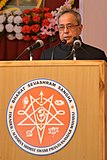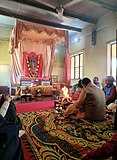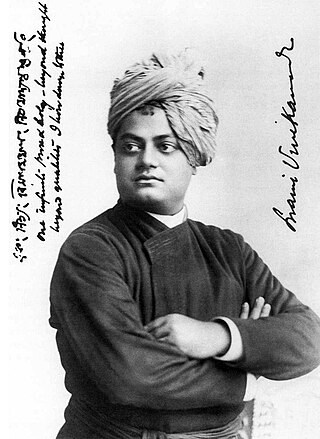
Swami Vivekananda, born Narendranath Datta was an Indian Hindu monk, philosopher, author, religious teacher, and the chief disciple of the Indian mystic Ramakrishna. He was a key figure in the introduction of Vedanta and Yoga to the Western world. He is credited with raising interfaith awareness and bringing Hinduism to the status of a major world religion in the late nineteenth century.

Kolkata, also known as Calcutta, is the capital and largest city of the Indian state of West Bengal. It lies on the eastern bank of the Hooghly River, 80 km (50 mi) west of the border with Bangladesh. It is the primary financial and commercial centre of eastern and northeastern India. Kolkata is the seventh most populous city in India with an estimated city proper population of 4.5 million (0.45 crore) while its metropolitan region Kolkata Metropolitan Area is third most populous metropolitan region of India with a metro population of over 15 million. Kolkata is regarded by many sources as the cultural capital of India and a historically and culturally significant city in the historic region of Bengal.
Hridaypur is a neighbourhood in Barasat of North 24 Parganas district in the Indian state of West Bengal. It is a part of the area covered by Kolkata Metropolitan Development Authority (KMDA).

Baranagar is a city and a municipality of North 24 Parganas district in the Indian state of West Bengal. It is a part of the area covered by Kolkata Metropolitan Development Authority (KMDA).

Behala is a locality of South West Kolkata in the Indian state of West Bengal. Behala is a part of Kolkata Municipal Corporation area. It is broadly spread across Ward Nos. 118, 119, 120, 121, 122, 123, 124, 125, 126, 127, 128, 129, 130, 131 and 132 of the Kolkata Municipal Corporation and is divided into two Vidhan Sabha constituencies: Behala Paschim and Behala Purba. This area is served by the South West Division of Kolkata Police also known as Behala Division.

The National College, Trichy is an autonomous institution, located in Tiruchirappalli, Tamil Nadu. It was recognized as the 'College with Potential for Excellence' by the University Grants Commission in 2011. The college is ranked 82nd among colleges in India by the National Institutional Ranking Framework (NIRF) in 2024.
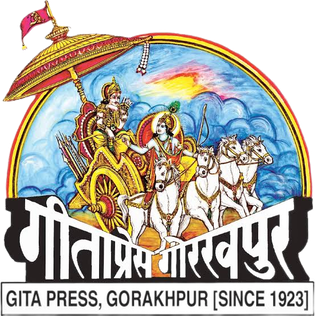
Gita Press is an Indian books publishing company, headquartered in Gorakhpur, Uttar Pradesh, India. It is the world's largest publisher of Hindu religious texts. It was founded in 1923 by Jaya Dayal Goyanka and Ghanshyam Das Jalan for promoting the principles of Hinduism. Hanuman Prasad Poddar better known as "Bhaiji" was the founding and the lifetime editor of its noted magazine who also wrote articles with his pen name Kalyan.

The Noakhali riots were a series of semi-organized massacres, rapes and abductions, combined with looting and arson of Hindu properties, perpetrated by the Muslim mobs in the districts of Noakhali in the Chittagong Division of Bengal in October–November 1946, a year before India's independence from British rule.

Acharya Mahashraman is the eleventh Acharya, supreme head of Jain Śvetāmbara Terapanth sect. Mahashraman ji heads all activities functioning under Terapanth organisation, most notably Anuvrat, Preksha Meditation, Jeevan Vigyan. All the Terapanth sub-organisations, notably. Jain Vishva Bharati, Terapanth Mahasabha, etc. are working under the guidance of Acharya Shri Mahashraman. His views are liberal and secular. He has a firm conviction to promote nonviolence, moral values and principles.
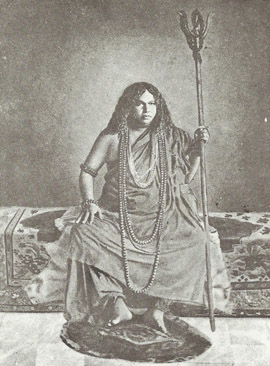
Swami Pranavananda also known as Yugācāryya Śrīmat Svāmī Praṇavānanda Jī Mahārāja, was a Hindu yogi and saint who founded a not-for-profit spiritual organization known as the Bharat Sevashram Sangha.

Narendra Modi, who is serving the Prime minister of India since 2014. The following is a timeline of the premiership from his inauguration as Prime Minister of India on 26 May 2014 till now.

Baranagore Ramakrishna Mission Ashrama High School (H.S.) (BRKMAHS) is a senior secondary boys' school in Baranagar, Kolkata, India and a branch centre of Ramakrishna Math and Ramakrishna Mission, Belur Math. The school was founded in 1912, and is located at the northern outskirt of Kolkata, on the banks of the river Ganga. The school is run by the Baranagar Ramakrishna Mission Ashrama Authority under the umbrella of Ramakrishna Mission headquartered at Belur Math. Based on its performance of the students in the Xth standard board examination, the school is considered one of the very best schools in West Bengal. Department of Tourism listed it as one of the tourist spots of West Bengal.
Nisith Ranjan Ray(19 November, 1910 – 7 September,1994) was an Indian historian, social activist and the founder of the Society for Preservation, Calcutta, an organisation working for the preservation of the cultural heritage of Kolkata.
The All India Institutes of Medical Sciences (AIIMS) is a group of autonomous government public medical universities of higher education under the jurisdiction of Ministry of Health and Family Welfare, Government of India. These institutes have been declared by an Act of Parliament as Institutes of National Importance. AIIMS New Delhi, the forerunner institute, was established in 1956. Since then, 24 more institutes were announced.

Super Cyclonic Storm Amphan was an extremely powerful and catastrophic tropical cyclone that caused widespread damage in Eastern India, specifically in West Bengal and Odisha, and in Bangladesh, in May 2020. It was the strongest tropical cyclone to strike the Ganges Delta. It was a rare cyclone that lashed northern Bangladesh from Rajshahi to Rangpur in the early hours of 21 May with strong winds. It caused severe damage to mango production of Rajshahi and Rangpur. It was also the fourth super cyclone that hit West Bengal and Kolkata since 2015 as well as being one of the strongest storms to impact the area. Causing over US$15 billion of damage, Amphan is also the costliest cyclone ever recorded in the North Indian Ocean, surpassing the record held by Nargis of 2008.

The effects of the 2020 North Indian Ocean cyclone season in India was considered one of the worst in decades, largely due to Super Cyclonic Storm Amphan. Throughout most of the year, a series of cyclones impacted the country, with the worst damage occurring in May, from Cyclone Amphan. The season started with Super Cyclonic Storm Amphan, which affected East India with very severe damages. 98 total people died from the storm. Approximately 1,167 km (725 mi) of power lines of varying voltages, 126,540 transformers, and 448 electrical substations were affected, leaving 3.4 million without power. Damage to the power grid reached ₹3.2 billion. Four people died in Odisha, two from collapsed objects, one due to drowning, and one from head trauma. Across the ten affected districts in Odisha, 4.4 million people were impacted in some way by the cyclone. At least 500 homes were destroyed and a further 15,000 were damaged. Nearly 4,000 livestock, primarily poultry, died. The cyclone was strongest at its northeast section. The next storm was a depression that did not affect India. Then Severe Cyclonic Storm Nisarga hit Maharashtra, with high damages. Nisarga caused 6 deaths and 16 injuries in the state. Over 5,033 ha of land were damaged.

Cyclone Amphan was the costliest tropical cyclone ever recorded in India and the North Indian Ocean, and the strongest cyclone ever since the 1999 Odisha Cyclone. It was the first storm, and strongest of the historic 2020 North Indian Ocean cyclone season, the costliest recorded cyclone season. It made landfall in West Bengal with 100 mph winds. Within India, the storm killed 103 people, and caused $14 billion in damage. Amphan produced extremely high winds that ripped roofs off houses and uprooted trees, and storm surges of 15 ft (4.6 m) in areas like Digha, West Bengal.
The Tala tank, also spelled Tallah tank, is a water tower in Kolkata, West Bengal, India. Construction started in 1909 and it was inaugurated in May 1911 by Edward Norman Baker, the Lieutenant Governor of Bengal. The tank, which is owned by Kolkata Municipal Corporation, is fed by Palta Water Works near Barrackpore. More than 110 years after construction, the tower remains the major water supplier to the city of Kolkata.





